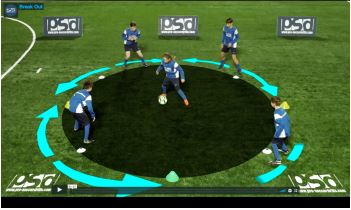Basics of the 4-1-4-1 Formation
Setup
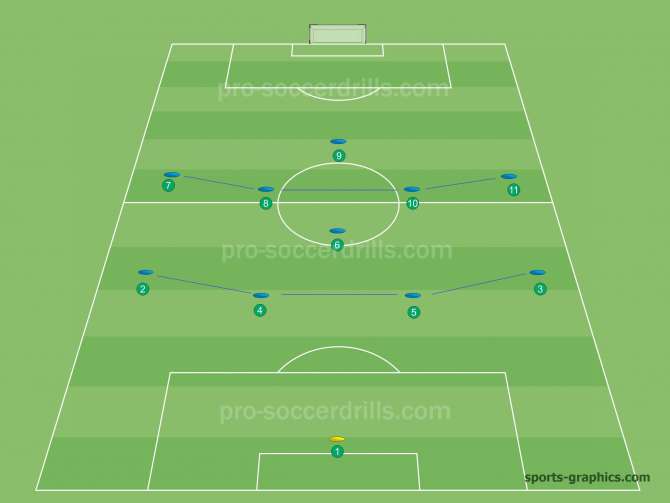
The 4-1-4-1 formation consists of four defenders (the back four), a holding midfielder (pivot), four midfielders and a striker. The idea of the 4-1-4-1 system came from the very well-known 4-4-2 system. The 4-4-2 system of play has a disadvantage in defence because there are no players covering the space between the midfield and the defence. That's why some coaches put another holding midfielder (number 6) there instead of playing with 2 strikers. With this change the four midfielders can play with more freedom.
The back four
The back four in this formation should be a typical flat back four who should be defending as a unit using the defensive mechanism first used and developed by Arrigo Sacchi.
The two centre backs should be good at defending individually because there is only one defensive midfielder that covers the space in the front of them. Coaches should choose their centre backs according to the opponent's style and formation. If the opponent is playing with two strikers, then coaches should ask their defensive midfielder to help the centre backs more in defence.
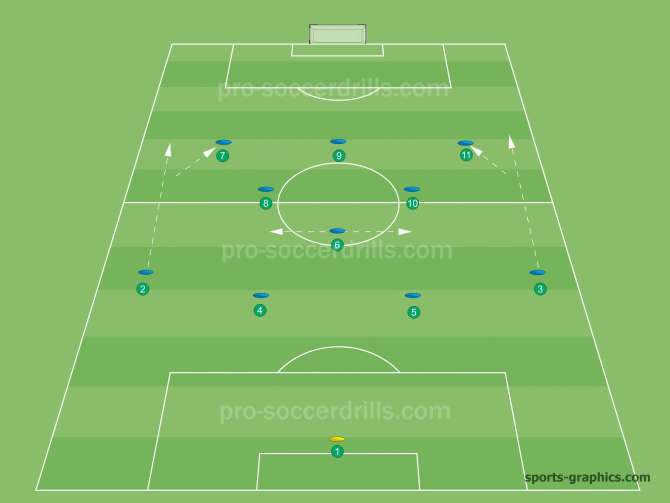
In attack, the full backs can leave their original position as they have more room to go forward because the two wingers (wide midfielders) will play higher.
That's why full backs should have a high lactate threshold (LT) to execute many sprints on the flanks.
They also have to time their runs well when overlapping the wide midfielders.
This may lead to 2v1 situations: Preparing Crossing Opportunities and Finishing from the Box
Another 2v1 soccer game: 2v1 Situations and Finishing
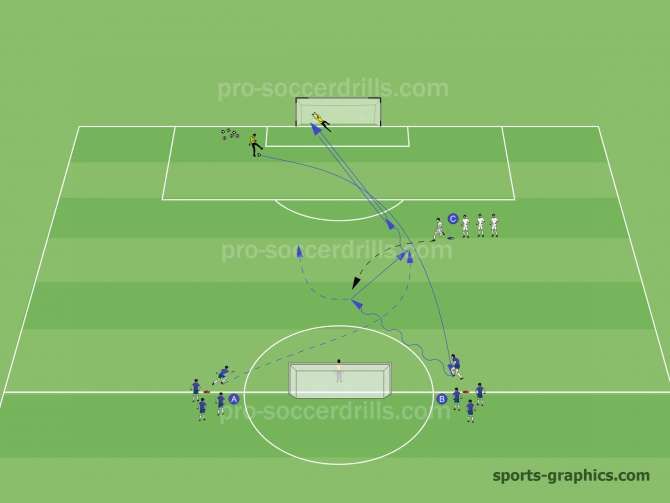
The Holding Midfielder
The holding midfielder is key when using the 4-1-4-1 system of play. He should be the most clever player of the team who is also able to defend well. He doesn't have to mark a man, he can cover space in the front of the defence and intercept passes towards the opponent's striker(s). He also has to help the two centre backs when needed so the holding midfielder has to be a "captain" in midfield. He needs to order his teammates when needed so the number 6 should be the coach's right-hand man on the pitch.
He also has to contribute to the build-up play. The two centre backs separate when building the attack and the holding midfielder drops back between the two. If he is marked by an opponent player he has to realise that and move out of the area as soon as possible to open up space for the other two central midfielders (he starts the interchanging movements when needed).
He should stay back in attack to give the full backs more freedom going forward. This midfielder is similar to the midfielder used in the 4-3-3 system (with one defensive mid).
The Four Attacking Midfielders
The 4-1-4-1 formation gives the coaches many options to choose the appropriate tactics for a game. If the opponent is playing with a flat back four, the coach can ask one of the central attacking midfielders to go forward and help the striker dragging a defender away from him.
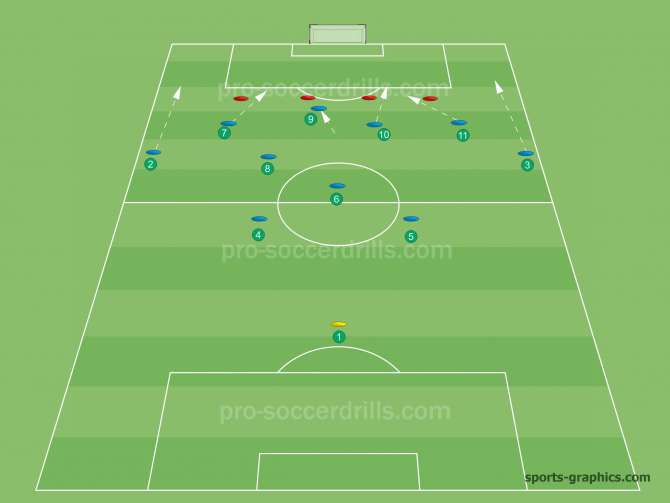
This move will make the opponent's defenders decide who to go with. This can lead to 1v1 situations in front and is a really useful tactics to apply. Coaches can also ask this central attacking midfielder (number 10) to be patient with their runs and make the overload in midfield for his team to keep possession. This is why at least one of the central midfielders should be good at making runs behind the opponent.
The roles of the two central attacking midfielders can be changed of course but this is a great way to break through the opponent's defence in the centre of the pitch.
The two wide players should be either good with their feet (dribbling) and their head to get into the box for crosses. (Width of the team should be given by the wide midfielders or the full backs.) This will help in possession stretching the opponent and will give the best angle for making runs into the penalty area.
The Number 9
Using this system of play the lone striker can be either a false 9 or a real finisher. This system gives the opportunity to change tactics during the game asking the striker to do different movements. He can drag his defenders away from their original position to create space for the attacking midfielders (number 8 and 10) to make runs into and be played the ball. The number 9 should always look for the space between the opponent's centre back and full back. This might confuse the two centre backs and they might lose the lone striker. This movement also gives a great angle to be ready for the through balls behind the opponent's defence.
Tactical Movements Of The 4-1-4-1
Pressing
There are plenty ways of pressing high on the pitch as there could be countless triggers used. The first thing needed for pressing is a good defensive team position. The team that is going to press has to be organised as there should not be any spaces left free. A good example to take a look at the pressing game is when the opponent has a goal-kick.
The defending team fakes the dropping back and let the opposition make the first pass of the build-up play. Therefore the first pass of the goalie can be the trigger for pressing. Secondly, the defending team has to take control of the game and force the opponent to play what the defending team wants to.

After the first pass, there should not be any free passing options for the attacking team so every defending player need to mark a man or cover some space (to be able to intercept passes - cut passing lanes). This is why the lone striker needs to force the opponent play towards the flanks. The midfield "three" is key (The midfield three now involves the two central midfielders and the holding midfield player.) when pressing. As shown on the picture above, they might need some interchanging movements depending on the opponent's system of play and tactics. There should always be a cover player (holding midfielder position). This is why clever midfielders are very important for pressing.
The rest of the players should be in charge of free spaces or man unmarked. These movements will force the opponent to play long.
Build-up
Build-up plays usually depend on the team's style of play, the characteristics of the players and the game situation.

Good team organisation is key for the build-up play. The two center backs separate and the holding midfielder steps into space. It is really important for the centre backs to position themselves in the right place with good body orientation. They need to see the whole pitch and this is why they need to position themselves in line with the goalkeeper (or possibly behind the line of the goalie). This will give them a good angle to control and play the ball forward.
There are then 4 options for the center back. It is expected that every player will be marked so the attacking team needs tactical movements to open up and use spaces.
The full back should try to lose his marker while the wide midfielder comes towards the place of the central midfielder. The attacker should always be ready for the long ball behind the defenders.
Note that this is just an example.
Read more in following drill: Building Attacks in a 4-1-4-1 Formation
Compact Defending
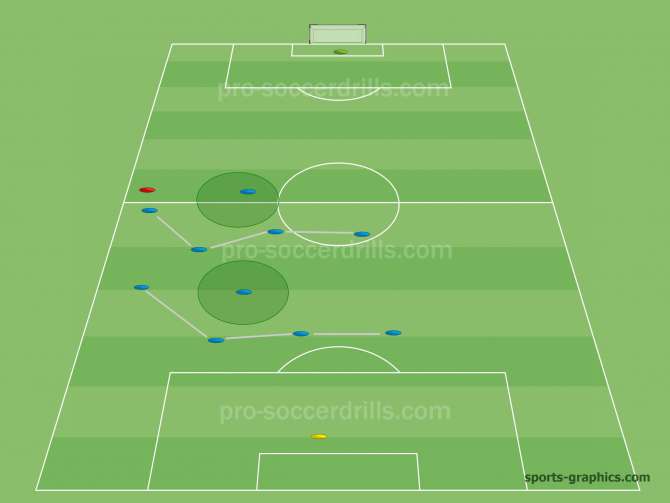
Players need to be organised again by applying the defensive method developed by Sacchi. This formation has two lines of four so it is easier to coach. The defensive player on the far side comes in until the centre line.
Advantages and disadvantages of the 4-1-4-1
Advantages
- It makes easy to practice defensive movements (4-1, 4-1 formation)
- Has many attacking options
Disadvantages
- Can be counter-attacked
- Wide players should defend more
Positional Requirements
| Position | Physical | Tactical | Technical | Mental |
| GK | Know the build-up play | Good with his feet | Helping the build-up Optimal risktaking |
|
| CB | Mark the striker | Helping the build-up, separating Good body orientation |
Good with his feet | Optimal risktaking |
| FB | High LT (Repeated Sprint Ability) | Good at overlapping runs Solving 2v1 situations |
Good at crossing | Good timing |
| CDM | Being the coach's right-hand man on the pitch Great interceptor |
Very good with his feet | Knowing the tactics and principles Helping the teammates |
|
| CM | High attacking work-rate | Able to keep possession Finding space between lines |
Good on the ball | Always scan the field |
| WM | High defensive work | Giving width | Good dribbler | Making well-timed runs |
| ST | Strong in the air Make many short runs |
Dragging the CBs | Good in 1v1s either on the ground and in the air | Knowing when to drop back to keep possession Finding and creating space |
Summary
There is only a little between the 4-1-4-1 and the 4-3-3, but 4-1-4-1 may be an easier formation to coach because there is a back four and a player in the front of them and a midfield four and another player in the front of them.
Free Trial
GET YOUR FREE 14 - DAYS TRIAL NOW! INCLUDING:




